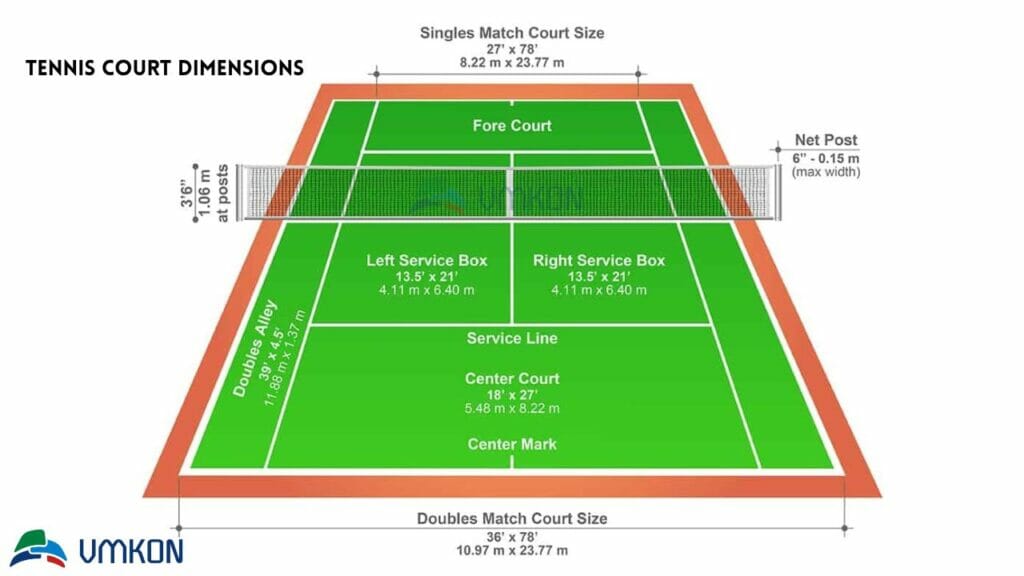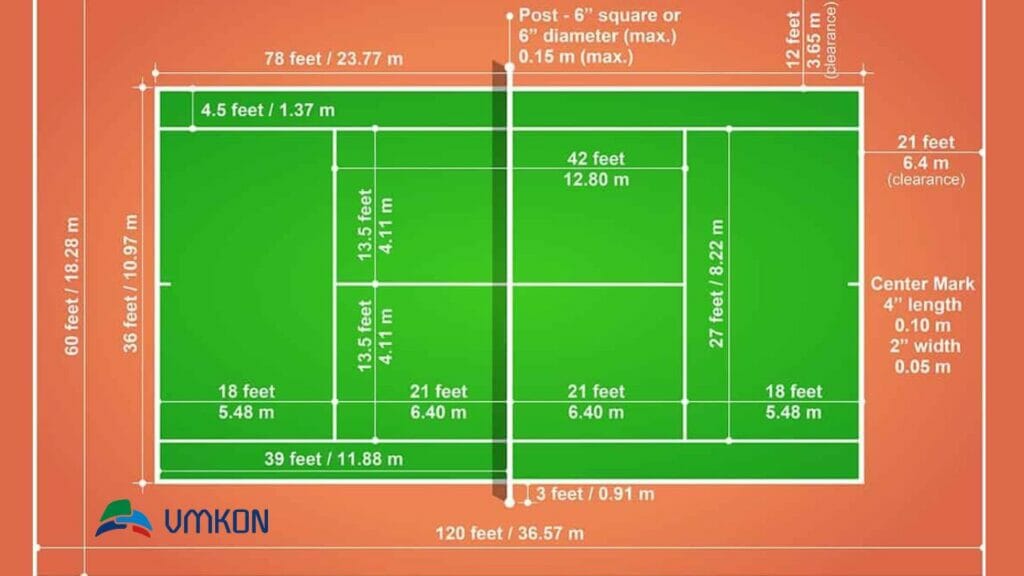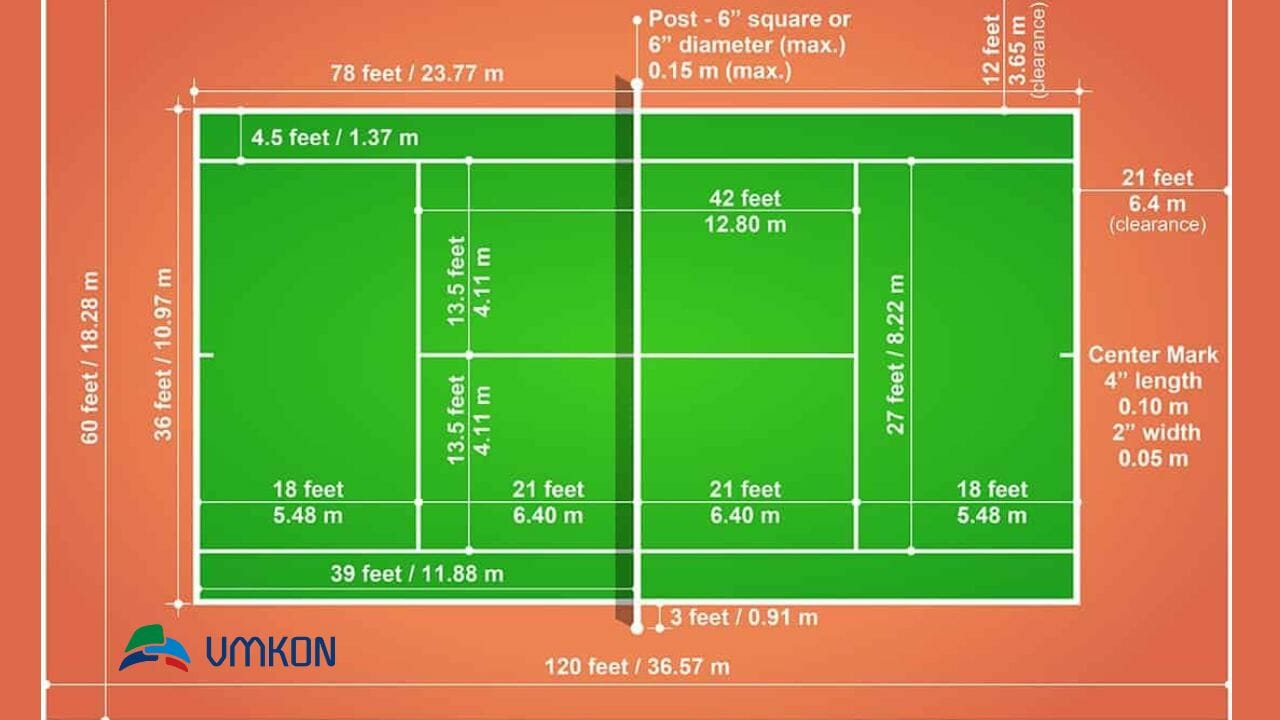Tennis court dimensions can vary depending on the type of court, the surface, and the level of competition. The dimensions of a tennis court are regulated by the International Tennis Federation (ITF) and are used in all levels of competition, from amateur to professional.
Knowing the dimensions is important if you want to build a tennis court. The size of a tennis court can vary depending on the type of court, the level of play, and the age of the players.
The dimensions of a tennis court are also different for singles and doubles matches.
In this article, we’ll give you a comprehensive guide to tennis court dimensions. We’ll cover the dimensions of a tennis court for singles and doubles matches and the dimensions of different types of courts.
Let’s get started learning about tennis court dimensions meters.
Dimensions & Layout of Tennis Courts
Tennis courts are rectangular in shape and typically measure 78 feet in length and 36 feet in width, with a total area of 2,808 square feet.

However, the full court area is used only for doubles matches, while singles matches are played on a smaller court that measures 78 feet in length and 27 feet in width, with an area of 2,106 square feet.
There is no question that each component of a tennis court plays a significant role in the game, and players need to understand their dimensions and layout if they want to master the game.

Let’s take a closer look at each element of aLines of a Tennis Court.
Baseline: Doubles 36 feet / Singles 27 feet
Each baseline defines the back of the court, the farthest point on each side of the net. Players hit most of their groundstrokes (forehands and backhands) from this area, and any shots that land beyond this line are considered out of bounds.
Center Mark: 4 inches long
Baseline center marks are vertical to the net and divide the baseline in half. It defines the point players cannot cross when hitting a serve in either the deuce or ad court.
After hitting a groundstroke, coaches often instruct players to return to the center of the baseline, making it an essential point of reference.
42 feet long center service line
Two equal-sized service boxes are created at the intersection of the center service line and the service line, which run perpendicular to the net. This line divides the court in half, providing an excellent player reference point during play.
27 feet wide service line
The service line runs parallel to the net and marks the halfway point between the net and the baseline. It also marks the end of the service boxes, but unlike the baseline, it extends only to the single’s sidelines. If a serve lands beyond this line in the court, it is considered out.
39 feet long doubles sidelines
The doubles sidelines are located a few feet outside the singles sidelines, running perpendicular to the net. They define the side boundaries of the court for doubles matches, providing ample space for two players on each side of the net.
39 feet long singles sidelines
Singles matches are played with a perpendicular singles sideline running perpendicular to the net and defining the boundaries of the player’s area of the court. Players must keep their shots within these lines to avoid being called out.
Different Areas of the Tennis Court
Tennis is a sport that requires precision, skill, and a solid understanding of the dimensions and layout of the court. Knowing the areas of the tennis court is important for players, coaches, and spectators alike.

Let’s take a closer look at each tennis court area and its purpose.
Service Box
The service box is the area where the server must stand while serving. It is a rectangular area that measures 21 feet (6.4 meters) in length and 13.5 feet (4.1 meters) in width.
Each service box has an area of 283.5 square feet (26.3 square meters). The server must hit the ball within the service box for the service to be considered in play.
Doubles Alley
The doubles alley is located on the court’s outer side and is used only during doubles play. It measures 39 feet (11.9 meters) in length and 4.5 feet (1.4 meters) in width, with a total area of 175.5 square feet (16.3 square meters). The doubles alley expands the court’s width for doubles play, creating more space for players to hit the ball.
Center Line
The center line runs perpendicular to the net and divides the court into two halves. It is only 4 inches long and is used as a reference point during serves. The server must stand behind the center line and within the service box when serving.
Backcourt (No Man’s Land)
The backcourt, or no man’s land, is the area between the service line and the baseline. It measures 18 feet (5.5 meters) in length and 27 feet (8.2 meters) in width, making the tennis court a total area of 486 square feet (45.2 square meters).
This area is called no man’s land because it is considered difficult to play from, as it is too far from the net to make an effective volley and too close to the baseline to hit a comfortable groundstroke.
Tennis Court Net Height
The net is a crucial element in tennis that divides the court into two halves. A cable suspends it; its height is 3 feet (0.9 meters) in the center and 3.5 feet (1.1 meters) at the net posts. The net’s height creates an ideal challenge for players to hit the ball over the net while ensuring it lands within the court.
Choosing the Best Tennis Court Size for Your Home
Tennis enthusiasts who want to enjoy the sport in the comfort of their own backyard often wonder about the best size for their home tennis court.

While available space is the most important factor, it is also essential to consider the recommended backyard tennis court dimensions to ensure an optimal playing experience.
This section will discuss the different sizes of tennis courts and the ideal dimensions for a home court.
Minimum Play Area for Home Tennis Court
A tennis court size in feet for a home is 98.4 feet (30 meters) long by 49.2 feet (15 meters). However, it is recommended not to build a court within a play area smaller than this size. A smaller court may restrict your movement and limit your ability to hit the ball properly.
Ideal Play Area for Home Tennis Court
For an optimal playing experience, the ideal play area for a home tennis court is 110 feet (33.5 meters) long by 53 feet (16.2 meters) wide.
This size allows players to move freely around the court and hit the ball from different angles without feeling cramped. Additionally, it offers enough space to install fencing, lighting, and other court amenities.
Maximum Play Area for Home Tennis Court
The maximum play area for a home tennis court is 119.75 feet (36.5 meters) long by 59.7 feet (18.2 meters) wide. A larger court may not be practical for most homeowners, but it can provide a more suitable playing surface for experienced players who want to practice their shots and footwork.
In short, When choosing the tennis court size for home, it is crucial to consider the available space and the recommended court dimensions. While a smaller court may be more practical for some, a larger court can provide a more useful playing surface and allow for more flexible shots. Ultimately, the best size for your home tennis court will depend on your specific needs and preferences.
Measuring a Tennis Court: Tips and Tricks
Measuring a tennis court may seem simple, but it is important to do it correctly to ensure the court is within regulation size. Here are some tips to help you measure a tennis court accurately.

Standard Tennis Court Size
Generally, a tennis court should have a minimum length of 120 ft. and a minimum width of 60 ft, resulting in an area corresponding to 7,200 sq. ft. However, the standard playing area of a tennis court measures 78 ft. in length and 36 ft. in width for doubles matches, giving a total playing area of 2,808 sq ft.
Courts for Tournaments or Stadiums
For tournament or stadium courts, it is recommended to add an extra 10 ft. on both the length and width of the overall dimensions of the court to provide additional perimeter area for judges and player overrun. Due to this, the total length of the court would be 130 feet, and the total width would be 70 feet.
Measuring Tennis Court Dimensions
When measuring the court dimensions, measuring the outside of the line is essential to get the correct measurement. The center line and center mark should be measured on the centerline of the court.
Side Space and BackSpace
Leaving enough space along the sides and back of the playing area is crucial. A minimum of 12 ft. from the sideline to the fence, divider curtain, or any fixed obstruction is required. A minimum of 21 ft. Measuring from the baseline to the fence or backdrop is also necessary.
Overhead Space
It is recommended, in order to avoid accidents, that the minimum overhead clearance above the baseline and 35 feet above the net in indoor facilities should be 20 feet free of obstructions.
Backstops and Fences
It is recommended that the fencing or walls around a tennis court are a minimum of 8 feet high for residential courts and ten feet high for clubs or parks. This includes tennis court dividers and backdrops.
Tennis Court Markings
It is also important to note that the white lines that mark the court have standard thicknesses. A minimum width of 2 inches should be provided for all court lines, and a minimum width of 4 inches should be provided for the baseline.
Building a Tennis Court
Building a tennis court requires careful planning, consideration of the location, and the right materials. Here are the basic steps involved in building a tennis court.
Choose the location: The first step in building a tennis court is selecting the location. Consider the size of the court and the available space to ensure that the court will fit comfortably on the site.
Prepare the site: Preparing the site is the next step. Clear any vegetation or obstacles and level the ground to ensure a smooth, level playing surface.
Choose the right materials: Choosing the right materials is critical to the success of your tennis court. Consider factors such as durability, slip resistance, and maintenance requirements when selecting materials.
Install the court: Once the site is prepared and the materials are selected, it’s time to install the court. This typically involves laying down a sub-base layer, a drainage layer, and finally, the playing surface.
Add the finishing touches: The final step in building a tennis court is adding the finishing touches. This may include painting lines on the court, installing net posts, and adding fencing or barriers around the court.
VMKON Sports Courts.
VMKON SPORTS COURTS offers innovative, high-quality flooring solutions for indoor and outdoor home tennis courts. With our products, you can improve your athletic performance, increase stability, and enjoy affordability at the same time.
Our court tiles are specially designed to provide a good grip and prevent slipping, allowing you to take your tennis game to the next level.
Whether you’re a professional athlete or a tennis enthusiast, VMKON SPORTS COURTS‘ innovative flooring solutions are an excellent choice to enhance your playing experience.
Conclusion
tennis court dimensions can vary greatly depending on the type of court you are playing on and your level of play. However, understanding the basics of tennis court dimensions meters can help ensure that you are playing on a court that suits your skill level and the type of game you are playing.
Whether you are a beginner or an advanced player, being aware of the court dimensions can help you enjoy the game of tennis even more.
FAQs
1. What is the Standard Size of a Tennis Court?
The standard size of a tennis court is 78 feet (23.77 meters) in length and 27 feet (8.23 meters) in width for singles matches. For doubles matches, the width of the court is 36 feet (10.97 meters). It’s important to note that tournament or stadium courts may have slightly larger dimensions to provide additional space for judges and player overrun.
2. What is the Length and Width of the Tennis Court?
The standard length of a tennis court is 78 feet or 23.77 meters, while the standard width is 36 feet or 10.97 meters for doubles matches and 27 feet or 8.23 meters for singles matches.
3. What is a 60-foot Tennis Court?
A 60-foot tennis court is a type of tennis court that measures 60 feet in width. It is one of the standard sizes for a tennis court, with the minimum suggested width being 60 feet and the minimum suggested length being 120 feet. This court size is typically used for singles matches, while a 78-foot court is used for doubles matches.






